Car Accident Case With Spinal Injury Settled for $380,000
Car Accident Case With Spinal Injury Settled for $380,000
Earlier this week, lead trial counsel for Scottsdale Injury Lawyers, Tony Piccuta, obtained a $380,000 settlement for his client. The settlement was the result of a personal injury lawsuit that was filed after the client was in a low-impact, rear-end, car accident. The settlement was reached a few days before trial.
Details of the Personal Injury Lawsuit
The client was driving in a metro area when his vehicle was rear-ended from behind. The driver who rear-ended the client was driving a full-size SUV. The client’s vehicle did not sustain much damage. The estimate to repair the client’s vehicle was less than $2,000. The damage was mostly superficial. The vehicle that hit the client’s car did not sustain major damage either. The damage to the striking vehicle can be seen in the picture below.
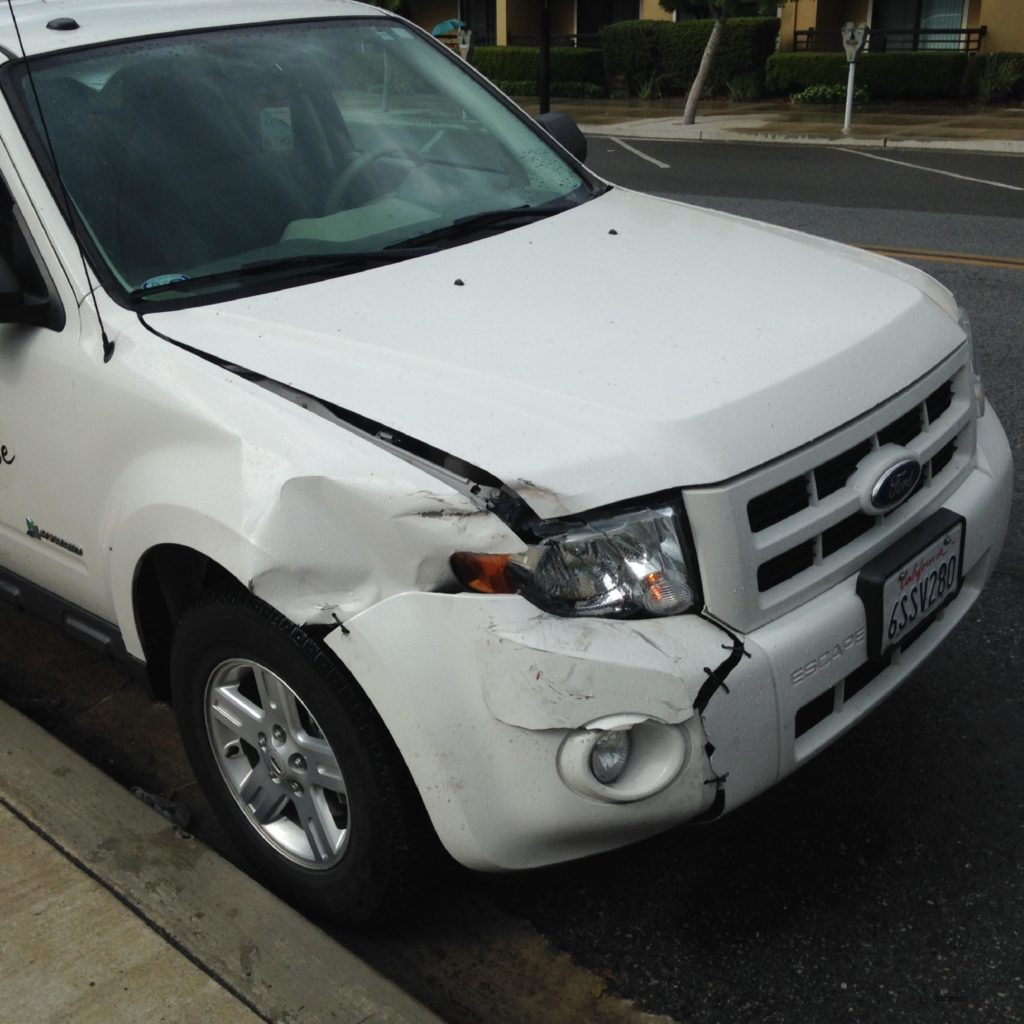
The client exchanged information with the other driver at the scene and then returned to work that day. The next morning, the client felt stiffness and pain in his neck and back. He went to an urgent care medical center for treatment. He received an x-ray that did not show significant injury and was diagnosed with whiplash (cervical strain) and degenerative disc disease (arthritic spine).
The client returned to urgent care a few more times in the next two weeks complaining of discomfort, stiffness and neck pain. The client was then referred to physical therapy. Over the course of the next two months, the client completed approximately ten physical therapy sessions. The client then decided that the physical therapy was not working and requested to be discharged.
The client did not receive any other medical treatment until a year later. About a year and a half later, the client met with a spinal surgeon complaining of continued neck pain and discomfort. The surgeon ordered an MRI of the client’s cervical spine. After reviewing the results, the surgeon told the client that he could perform a surgery that may relieve the client’s neck pain and symptoms. The client decided to try it.
The client received a surgical spinal fusion of two of his vertebrae and a discectomy of one of his cervical discs. In simple terms, he got a neck surgery with metal hardware and screws installed. The procedure included the removal of one of his spinal discs that the surgeon believed was pressing on his nerves and causing his pain and discomfort. Once the disc was removed, a metal cage was installed with titanium screws to maintain the spacing between the two vertebrae where the disc was taken out. The actual x-ray images of the client’s spine with the metal hardware installed are below.
-
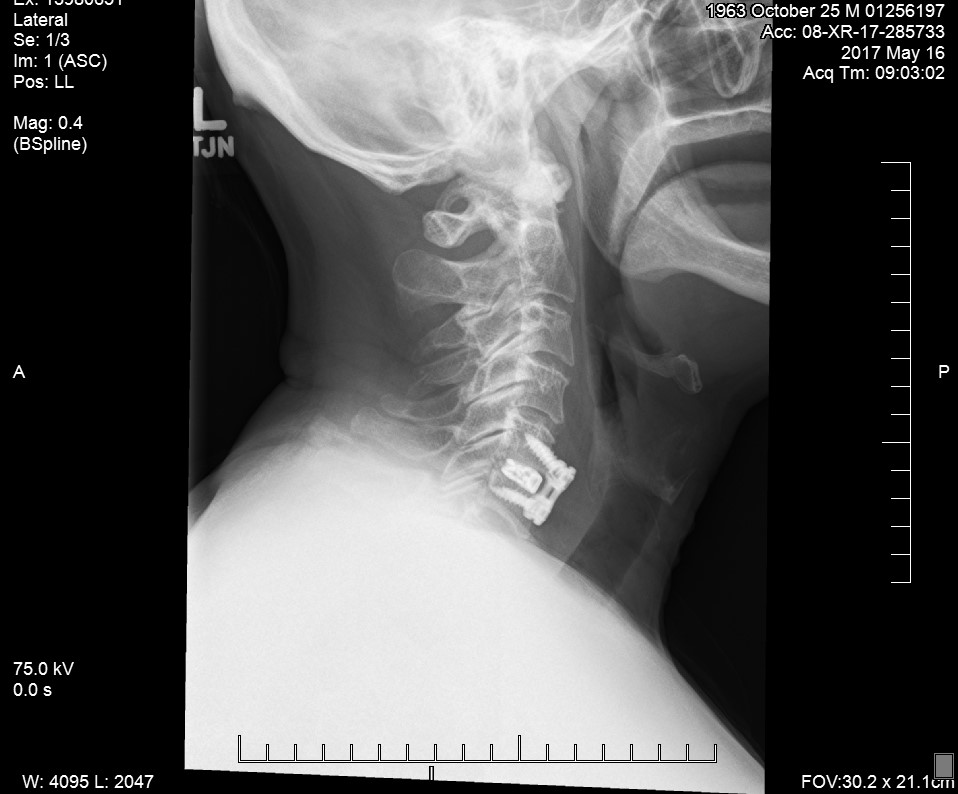
Side View of Client’s Surgical Implant -
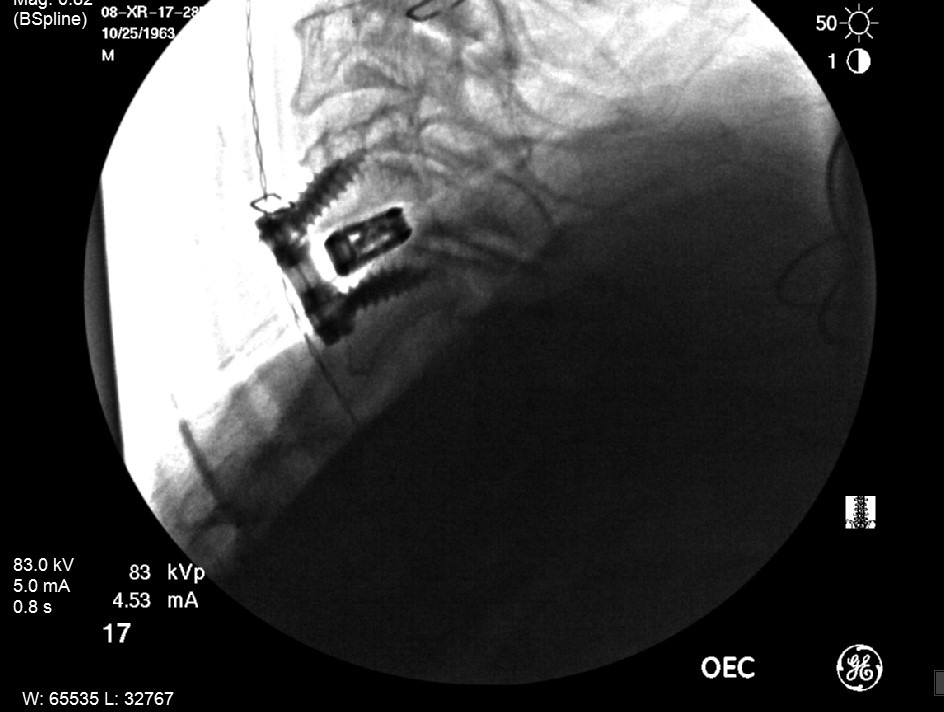
Hardware in Spine -
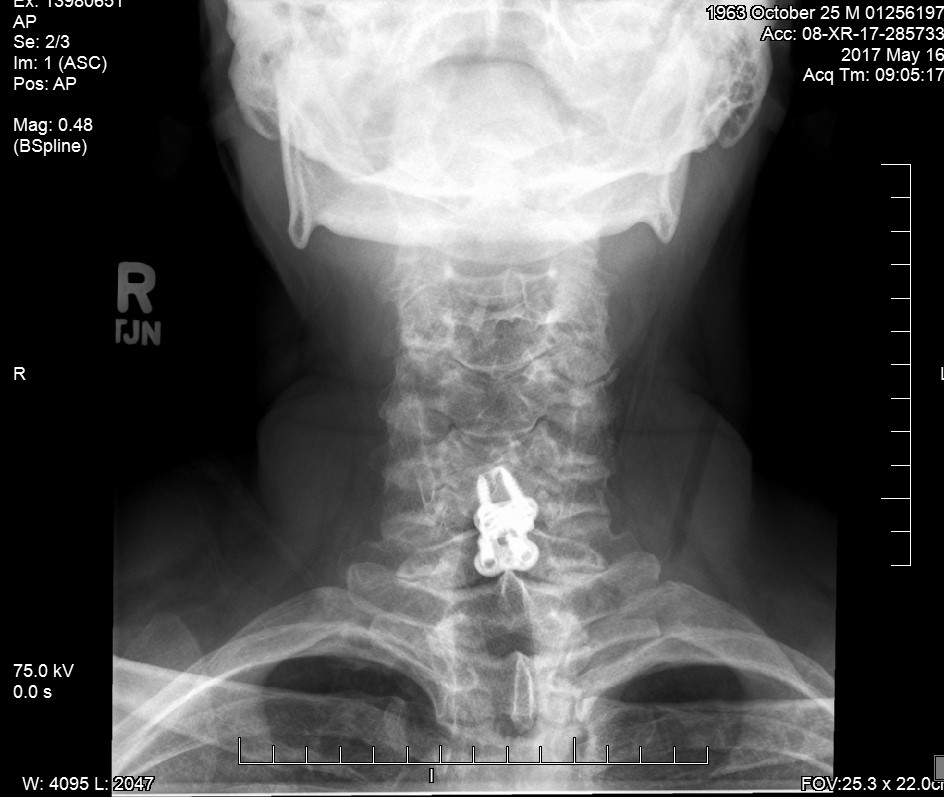
Front View of Client’s Surgical Implant
The Car Accident Case Had Several Challenges and Difficult Issues
All cases have some unfavorable facts and difficult issues to deal with. However, this particular case had more than normal. Each unfavorable fact emboldened the insurance company. The insurance company believed it could win the case and obtain a defense victory. As a result, the insurance company did not want to pay anything. Indeed, the insurance company did not consider settlement until the very end of the case when they were backed into a corner and with a trial looming.
The challenging issues of this particular case are listed below:
- The client had very serious neck problems prior to the crash. He had treated for years for neck pain, stiffness and discomfort. He had received previous MRIs of his neck and multiple epidural injections.
- There were several other factors that could have likely been the cause of the client’s neck problems. The client was a professional rodeo and bull rider when he was younger. The client also worked in construction for over twenty years and had a demanding labor-intensive position at the time of the accident.
- The client went approximately 18 months with absolutely no treatment before he decided to get the surgery.
- The client had arthritis and degenerative changes at every level of his cervical spine. There was nothing in his medical records that conclusively proved his injury was caused by a single event. In other words, it could easily be argued that his neck pain was simply the result of the natural progression of his degenerative disc disease and was not caused by the car accident.
- There was very little damage to either vehicle.
- The surgery the client received was provided on a medical lien.
- The client’s medical records showed he had a history of pain and depression. This minimized any claim for significant damages for these items. The defense could simply argue that his pain and depression was not caused by the crash but was constant throughout his life.
- The client had a significant criminal background and felony convictions. The client also had serious drug dependency and addiction problems.
- The case was initially filed by another attorney. Piccuta was only brought in at the last minute when that attorney realized that the insurance company would not settle and that the case would likely head to trial.
- The case was being handled by well-known insurance defense attorneys. Those attorneys were skilled and experienced and had compiled a record of defense victories for insurance companies.
Even with the above challenges, Piccuta dove into the case and began preparing it for trial.
Showing the Bad Facts In a Way that Supported Our Theory of the Case
In any case, a good personal injury attorney will take bad facts head on. The best way to deal with those facts is to get them out early and present them in a way that benefits the client. Unfavorable facts should never be hidden because they will always be found. This case was no different and Piccuta did exactly that.
The two most difficult facts of the case were: 1) the car accident was low-impact and there was little damage to either vehicle; and 2) the prior neck pain and spine problems the client had before the crash.
Piccuta argued that the client had fully recovered from his previous neck injury and that he was having almost no symptoms at the time of the car accident. Even if the client still had a neck condition at the time of the car accident, the symptoms were dormant. The client was largely unaffected and the client may have lived the remainder of his life without further problems or complications. However, that crash changed all that. In short, Piccuta argued that the car accident likely caused all his neck problems that occurred after the crash and resulted in his need for surgery.
In legal terms, Piccuta argued that the crash exacerbated an asymptomatic pre-existing condition. In plain language, this means that the car accident aggravated the client’s diseased neck condition and retriggered his neck problems. This happened at a point where the client had his pain symptoms under control and was no longer having significant neck problems.
Piccuta further argued, that although the car accident was a low-impact collision with little damage, it still created enough force to injure the client’s neck. This was because the client’s neck was especially vulnerable to injury. Where a healthy person without a diseased cervical spine may have been unaffected by the crash, that was not the client. The client’s neck was already compromised prior to the crash. While the low impact may not have caused any injury to someone else without a compromised cervical spine—it did to this particular client.
The Eggshell Plaintiff Rule Explained by a Scottsdale Injury Attorney
Arizona law directly supports the legal theories that Piccuta advanced for this client. Arizona law makes clear that you take your client as you find him or her. This principle is known as the “eggshell plaintiff” rule. In sum, even if the client is as fragile as an eggshell, if a person causes him or her harm, that person is liable.
In sum, even if the client is as fragile as an eggshell, if a person causes him or her harm, that person is liable.
The following example illustrates this point. If a person crashes his or her car into another vehicle at 15 miles per hour, it may not injure a physically fit, strong, young person. For example, Larry Fitzgerald may sustain the impact and forces from it without any issue or injury. His physical strength, stature, athleticism and flexibility, allow him to walk away unscathed.
On the other hand, if a 90 year-old, frail, grandmother was exposed to the same crash and forces, she could be seriously injured. She is thin. She is elderly. Her bones and muscle tissues are weak. She does not have the physical strength and stature to make it through that impact without sustaining a significant injury.
Another way to think about this theory is by thinking of two eggs. One eggshell has a crack in it. The other does not. The cracked egg still holds the contents inside without any problems. As does the egg without the crack. While a small tap on the egg without the crack would not cause any issue, a small tap on the cracked egg, could cause it to crack open. All the contents would then spill out and the shell would be destroyed.
Arizona law allows the previously compromised person to recover his or her full damages.
In either of the above examples, Arizona law allows the previously compromised person to recover his or her full damages. The analysis is not whether or not the car accident could have hurt the average person, the analysis is whether or not the car accident hurt the actual person in the vehicle. This is true even when the hurt individual was as frail as an eggshell. Piccuta argued that his client was unusually susceptible to injury due to the pre-existing issues in his cervical spine.
A Pre-existing Condition Can Be Helpful In Proving Injuries in a Low-Impact Car Accident Case
Proving an injury in a low-impact case can be hard. Oftentimes, if jurors and insurance adjusters do not see significant damage to the vehicles involved, they believe that significant injuries are unlikely. Defense attorneys and insurance companies routinely deny serious injury claims in car accidents where there is no significant damage to the vehicles. These individuals and companies believe that low-impact car accidents are not capable of causing forces that can result in serious physical injuries.
These same individuals and companies, rely on “studies” and “experiments,” usually funded by the insurance companies, to support this theory. These insurance-funded experiments are not the result of reliable scientific principles or methods. They are junk science.
These “studies” allegedly prove that low-impact car crashes create forces no greater than what the average person experiences in everyday living. The routine daily living activities that low-impact car crashes are supposedly equivalent to include:
- A sneeze
- Being slapped on the back by a friend who is greeting you
- Going over a speed bump at five miles per hour
- Sitting down into chair from a standing position
- Suddenly turning your head to look for something behind you
- Hopping off a curb with two feet
- Dropping backward into an office chair
People who have been in a low-impact car crash know that the forces created by it far exceed any of the daily activities mentioned above.
These “studies” are unreliable, irresponsible, and grossly biased. Of course, the individuals tested in these experiments are aware of their purpose. They know what will happen and can brace for any impact. Most importantly, these studies wholly fail to consider the individuals in the experiments. In other words, every individual is different and has a different injury threshold.
These experiments do not account for the unique medical conditions that someone may have. Instead, these experiments seek to extrapolate the results from the individuals in the experiments to every other person. However, there is simply no study that could determine what forces would be required to aggravate or reinjure Piccuta’s client and his specific medical condition.
A skilled personal injury attorney can debunk these “studies” and “experiments” and expose the defense teams that offer them. This is true in every case. However, it is especially true in a case where the client has a unique pre-existing condition and was especially vulnerable to an injury. Our injury lawyers believe that a client with a pre-existing injury actually makes a better Plaintiff than a perfectly healthy person when the case involves a low-impact collision.
Proving the Exacerbation of a Pre-Existing Condition Under Arizona Law
Under Arizona law, you must prove the following to recover damages for an exacerbation (aggravation) of a pre-existing condition.
- That you had a physical or emotional condition before the event or accident
- That your physical or emotional condition was aggravated or made worse by the event or accident
- That the at-fault party failed to use reasonable care
- That the aggravation or making worse of the condition would not have happened if the at-fault party had used reasonable care
- That you were damaged as a result
Arizona has a form of jury instruction specifically addressing this. It is entitled “Pre-Existing Condition, Unusually Susceptible Plaintiff. It sets forth:
[Plaintiff] is not entitled to compensation for any physical or emotional condition that pre-existed the fault of [Defendant]. However, if [Plaintiff] had any pre-existing physical or emotional condition that was aggravated or made worse by [Defendant’s] fault, you must decide the full amount of money that will reasonably and fairly compensate Plaintiff for that aggravation or worsening.
You must decide the full amount of money that will reasonably and fairly compensate [Plaintiff] for all damages caused by the fault of [Defendant], even if [Plaintiff] was more susceptible to injury than a normal healthy person would have been, and even if a normally healthy person would not have suffered a similar injury.
The Result Obtained By Piccuta in the Car Accident Case
Piccuta was able to secure a $380,000 settlement less than two weeks before trial. Prior to Piccuta working on the case, no settlement offers were ever made. Piccuta spent extensive time on the case, preparing it for trial and securing experts. The effort that Piccuta put forth resulted in a favorable settlement for the client under the difficult circumstances of the case. The amount the client will receive will make a difference in his life. The client can now buy a house and move his family into it.
The only way to get true value on a case, is to work it hard and to back the insurance company or defendant into a corner. The corner in every case is trial.
This case was no different than any other case in the sense that the insurance company did not want to write a six-figure check. Insurance companies and at-fault parties are simply not handing out bags of cash. The only way to get true value on a case is to work it hard and to back the insurance company or defendant into a corner. The corner in every case is a trial.
Scottsdale Injury Lawyers are willing to do the work to get the results you deserve. We will fight the case until the end and take your case to the jury as needed. We will not let the insurance companies decide what a case is worth. If we do not feel the insurance company is offering a fair amount to settle, we will present the case to a jury and let them make the decision. In the experience of our injury attorneys, insurance companies only offer real value when they are confronted with going to trial. In this case, the client sent the following thank you message which made fighting the case to the end worth it.
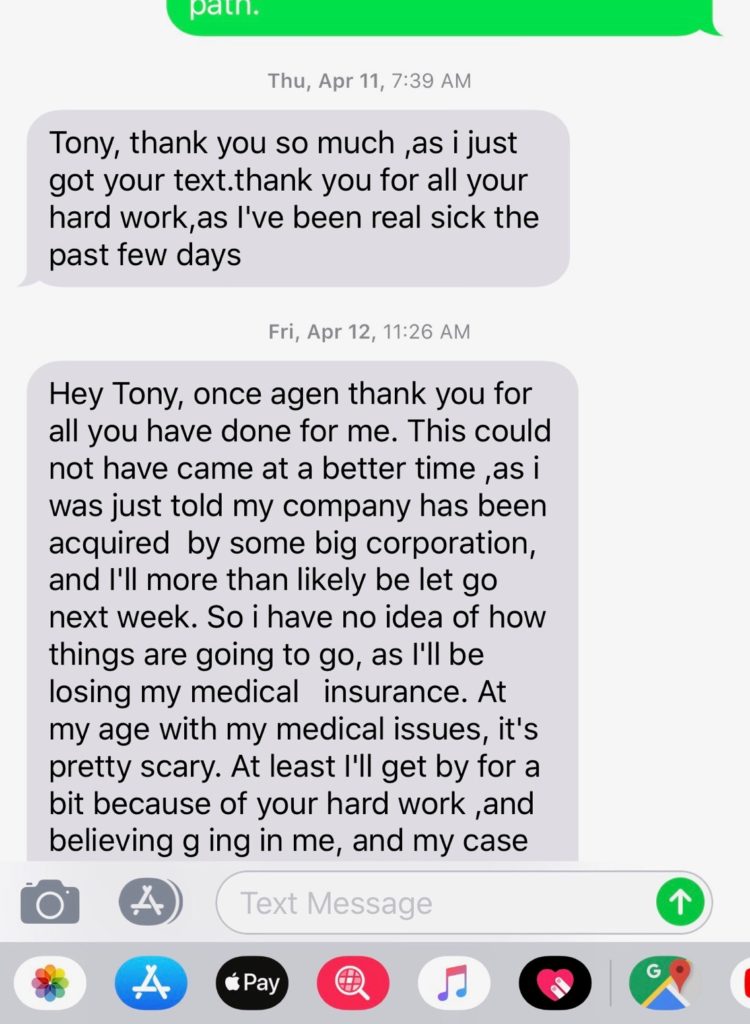
If you or a loved one needs an aggressive attorney who is willing to fight hard for you, contact Scottsdale Injury Lawyers today. A skilled Scottsdale personal injury attorney is available now to provide a free consultation.
About the author: The content on this page was written by Scottsdale personal injury attorney and civil rights lawyer, Tony Piccuta. Piccuta graduated with honors from Indiana University-Maurer School of Law in Bloomington, Indiana (Ranked Top 35 US News & World Report 2018). Piccuta took and passed the State bars of Arizona, California, Illinois, and Nevada (all on the first try). He actively practices throughout Arizona and California. He is a trial attorney that regularly handles serious personal injury cases and civil rights lawsuits. He has obtained six and seven-figure verdicts in both state and federal court. He has been recognized by Super Lawyers for six years straight. He is a member of the Arizona Association of Justice, Maricopa County Bar Association, Scottsdale Bar Association, American Association for Justice, National Police Accountability Project, and Consumer Attorneys of California, among other organizations.
Disclaimer: The information on this website is for informational purposes only and does not constitute legal advice. Reading and relying upon the content on this page does not create an attorney-client relationship. If you are seeking legal advice, you should contact our law firm for a free consultation and to discuss your specific case and issues.

